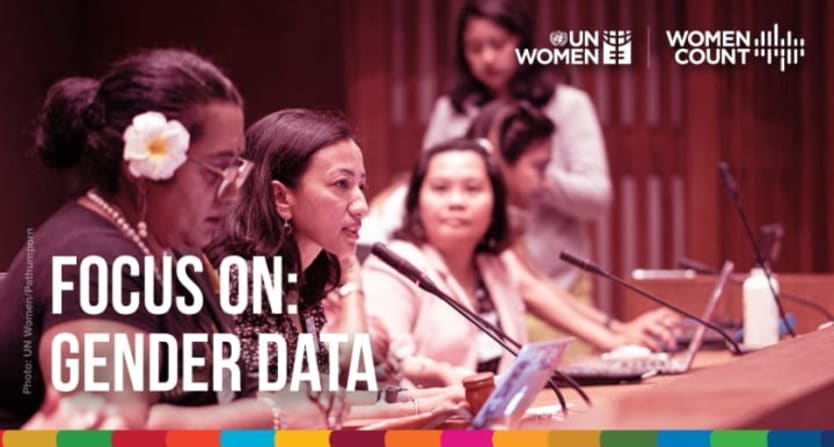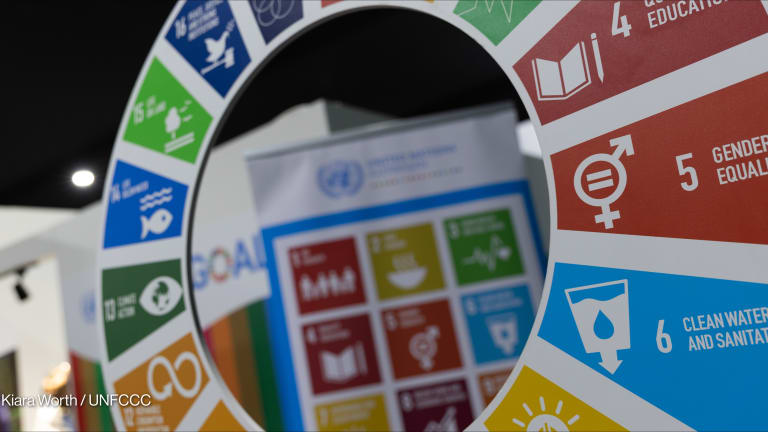
NEW YORK — Participatory gender data collection is gaining popularity among national statistical offices, increasingly blurring the lines between data users and data producers, according to Papa Seck, chief statistician at UN Women.
The process — which can involve directly engaging women’s civil society groups or grassroots networks in developing methodologies and questions — can yield more accurate data that is likely to be utilized, Seck said. But this practice also remains the exception to the rule of official data collection, due to the significant time, cost, and necessary relationship-building that accompanies a participatory process.
This article is part of Focus on: Gender Data
This focus area, powered by UN Women, highlights how data is being used to inform policy and advocacy to advance gender equality. Gender data is crucial to make every woman and girl count.
This form of data collection “has accelerated quite a bit with the SDGs [Sustainable Development Goals]. What is new now is the global statistics community is warming up to it, I would say,” Seck said.
“But bringing civil society together and on board is not an easy thing. And it is not just bringing them in for one survey; it is bringing them into a national statistical system that involves users and producers,” he continued.
Making participatory data happen
Ghana, Kenya, the Philippines, and Morocco have all opened their state-led data collection process to include women-led grassroots organizations and civil society organizations over the last few years. In Kenya, which plans to launch a time-use survey in January with support of the grassroots movement GROOTS, participatory data collection is a tool that helps women and men better understand their realities and ask the “right questions,” according to Fridah Githuku, GROOTS executive director.
“We got to a point where we were doing all the reflections, and we were like, ‘Why are these women always respondents?’ They provided data and it ended there,” Githuku said.
“The overall question is: What is leading us to more effective programming? What is leading us to reaching the needs of more conflict-affected populations?”
— Laura Tashjian, rapid gender analysis coordinator, CAREFinding a place for grassroots women in official statistics offices in Kenya, though, has not been easy, Githuku said. GROOTS has trained more than 2,000 women to conduct their own household surveys on topics such as clean cooking technology and climate change using apps on their phones. But government officials have questioned the quality of their data and their methods, according to Githuku.
Conversations about harmonizing different data collection methods have helped GROOTS bridge the gap between its own data collection and involvement in official, government-led processes. Settling into this relationship has taken time, Githuku said.
“We are working to improve the government tools, but it has been a hard fight. They want to ask questions blindly without considering issues of gender, age, sexual orientation, all the things that really matter,” Githuku said. “And I think it's very difficult to break government traditions, and also they want to protect themselves. They do not want to collect some information.”
GROOTS now sits on a committee with the Kenya National Bureau of Statistics, advising on gender statistics. It has helped develop plans for the country’s time-use survey, which will not include initially proposed “anti-feminist” questions such as, “Is it OK for a husband to leave a wife with the household chores?”
“It is so difficult to explain to a government officer why that question is badly framed. They simply cannot get it,” Githuku said.
'Show me the numbers': The forces stalling gender data collection
Money is one — but not the only — challenge when it comes to collecting and producing gender data, female statisticians and other government officials tell Devex.
CARE International is an example of an international NGO that has also taken steps to move away from what can be considered extractive data collection, which typically does not involve respondents beyond their one-time answers. CARE has used a rapid gender analysis toolkit for the last several years that helps inform its humanitarian response planning but also prioritizes community engagement and transparency in its data collection.
Strong, preexisting relationships with local civil society organizations and networks can help facilitate more representative data collection and more effective programming, said Laura Tashjian, rapid gender analysis coordinator at CARE.
“The overall question is: What is leading us to more effective programming? What is leading us to reaching the needs of more conflict-affected populations?” Tashjian said.
Effective response is “reliant on trust-building and partnership-building,” Tashjian said. “An important aspect of this sort of reciprocal relationship of data collection ... comes down also to the quality of your relationships and the quality of your partnerships.”
Beyond data collection
As the term “extractive data” can mean different things to different people, the question of “participatory data” is also a nuanced idea, according to Tara Cookson, co-founder and director of feminist research consulting group Ladysmith. And it should not necessarily mean that women need to become involved in every step of data collection, which can place unnecessary burdens on them, Cookson said.
“The global conversation is starting to get fixated on women needing to be involved in every stage of the data process. I don't think that's exactly it, because we also don't want to assume that women have bucket loads of free time to now all of the sudden become data analysts and policymakers through every level of the policy process,” Cookson said.
“The real crux of it is: Do we need the data that we're collecting? So, is it absolutely necessary to collect X piece of data? Are we going to use the data that's collected? Is it actually going to be put to use in a way that benefits the person from whom the data was collected? That's another really important question,” Cookson continued.
But benefits of participatory data collection are often still evident, according to Seck, who said that when users are involved in the production and analysis of data, there can be “some great results with the data being used.” It can also help bridge a gap between government and civil society and improve issues of trust and information.
“That definitely gets addressed by bringing users on board, so everything is transparent and data collection is done in a way that everyone understands,” Seck said.
A recent survey on violence against women in Morocco, for example, included civil society organizations as official “listeners,” or process observers.
“There was far more trust at the community level when it comes to the survey because women that were being interviewed did trust the CSOs. As soon as the data came out, they started using the data themselves to advocate for new services in areas where there is less reporting of violence against women to address ome of these issues,” Seck said. “The fact that they were involved means they trusted the data and knew intimately what the challenges were.”
Devex, with support from our partner UN Women, is exploring how data is being used to inform policy and advocacy to advance gender equality. Gender data is crucial to make every woman and girl count. Visit the Focus on: Gender Data page for more. Disclaimer: The views in this article do not necessarily represent the views of UN Women.





